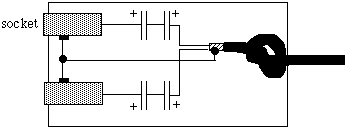
* We had some problems with a PC card before we discovered a large DC offset on the input: this is presumably there to supply power to electret microphones. You can of course avoid this problem, if you need to, by putting a large capacitance in series. You may not have this problem with yours. If you do, it might be worth making up the connector below. Two mono sockets that fit the inputs you wish to use are fitted on a small box (ideally metal to reduce electrical noise). Buy a cable with a stereo mini-phono jack on each end and cut it in half. Connect the shield of the cable to the ground pins of the sockets and the two leads inside to the signal pins of the two sockets via capacitors as shown. The capacitance C should be big enough so that 1/RC << any frequency you will look at. R, the input resistance of the sound card, is probably 10 k so you may want to put in several microfarads. A pair of small electrolytic capacitors connected back to back in polarity (as shown) will do. The knot in the cable takes the mechanical strain rather than the solder joints. For sturdy stuff, put a grommet in the hole where the cable passes through.

Macs are clever about this: the socket accepts standard small phono jacks with no offset, but the Mac microphone jack is longer and contacts the DC supply.
Lapel microphones are very good value for money. Flat response, little variability from one to another. We actually use them for serious measurements (although we calibrate them ourselves). Jack probably fits the sound card in your computers. Also buy some adaptors to connect to CRO inputs or whatever else you have, e.g. mini-phono to RCA to BNC.
Plastic conduit or sewage pipe makes great acoustical waveguides, and you can buy closed ends, corners etc ready made and relatively cheaply.
Violin bows or preferably double bass bows are good for exciting ~ continuous standing waves and for Chladni patterns in plates
Laser diodes can be bought from electronics stores. For several dollars you can buy the diode plus power supply. Just add a battery. Alternatively, buy an assembled laser pointer.
Several meters of thick, supple rubber hose, of the sort used to connect Bunsen burners, is useful in travelling and standing wave demonstrations and experiments
Polaroid sheet or lenses from polaroid sun glasses. Make your own petrological microscope. Also see some interesting wave effects in nature (polarisation of the sky, of reflections at intermediate angles from smooth surfaces). An old but really impressive demonstration requires three pieces: put two polarisers crossed (black) and now introduce a third piece at 45¡ between them.